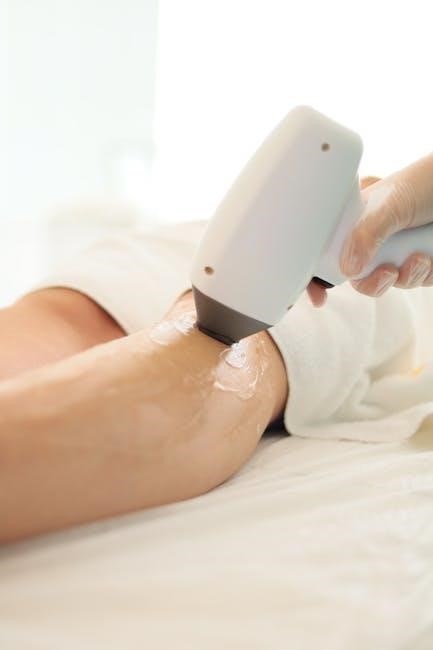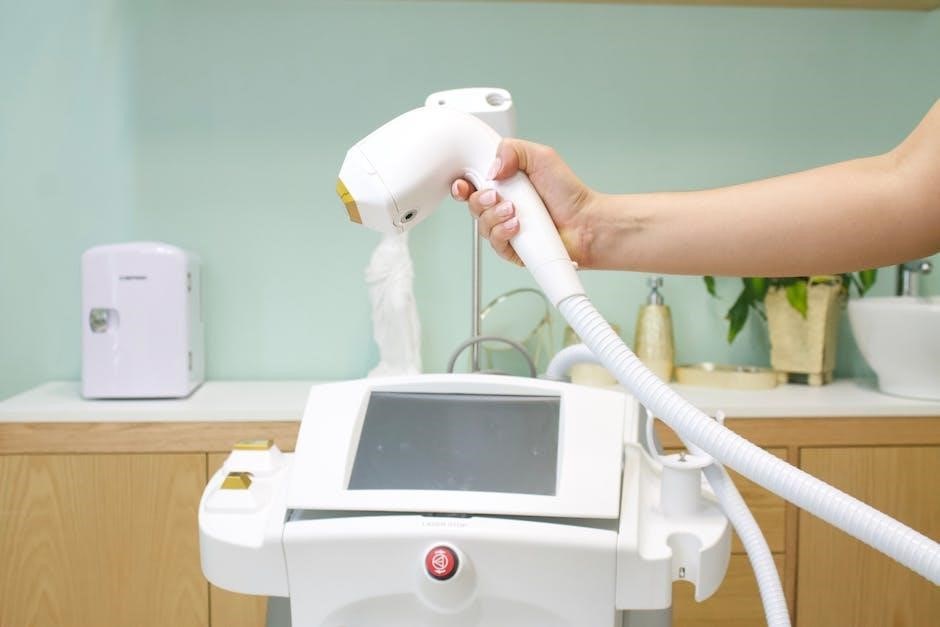Laser hair removal is a popular, non-invasive procedure using concentrated light to target and reduce unwanted hair. It offers long-term results, promoting smoother skin.
Overview of Laser Hair Removal
Laser hair removal is a non-invasive medical procedure that uses a concentrated beam of light to target and reduce unwanted hair. The laser emits light energy, which is absorbed by the hair follicle, damaging it and inhibiting future growth. This method is highly effective for most skin types and hair colors, though results may vary. It is commonly used on areas like the face, legs, underarms, and bikini line. Compared to traditional methods like waxing or shaving, laser hair removal offers long-term results, with many patients achieving permanent hair reduction after several sessions. The procedure is relatively quick, with minimal downtime, making it a popular choice for those seeking a convenient and lasting solution to unwanted hair.

Benefits of Laser Hair Removal
Laser hair removal offers numerous benefits, making it a preferred choice for many seeking long-term hair reduction. It provides permanent results, eliminating the need for frequent shaving, waxing, or plucking. The procedure is quick, especially for smaller areas, and requires minimal downtime. It reduces ingrown hairs and razor burn, making it ideal for sensitive skin. Unlike temporary methods, laser hair removal saves time and effort over time. It also reduces skin irritation and hyperpigmentation caused by frequent shaving. While initial costs may seem high, the long-term savings from avoiding regular hair removal treatments make it cost-effective. Additionally, it allows for smoother skin and boosts confidence, making it a worthwhile investment for many individuals.
Pre-Treatment Instructions
Before laser hair removal, avoid sun exposure, waxing, and tweezing for 4-6 weeks. Shave the area 24 hours prior and avoid makeup, lotions, and deodorants on the day of treatment.

Preparing Your Skin for Laser Hair Removal
Preparing your skin for laser hair removal is crucial for safe and effective treatment. Avoid waxing, tweezing, or using depilatory creams for at least four weeks before your session. This allows the hair follicle to remain intact, ensuring the laser can target it effectively. Shave the treatment area 24 hours prior to your appointment to prevent surface hair from burning. Additionally, avoid sun exposure and tanning beds for six weeks before treatment, as tanned skin can increase the risk of complications. On the day of the procedure, arrive without makeup, lotions, or deodorants, as these can interfere with the laser’s performance. Exfoliate gently to remove dead skin cells, ensuring the laser can penetrate evenly. Proper preparation helps minimize risks and enhances results.
Medications and Supplements to Avoid
Certain medications and supplements can interfere with laser hair removal, increasing the risk of side effects. Avoid blood-thinning medications like aspirin, ibuprofen, and warfarin for two weeks before treatment, as they may cause bleeding. Additionally, discontinue supplements such as vitamin E, fish oil, and St. John’s Wort, which can increase skin sensitivity. Retinoids, both topical and oral, should be paused for at least two weeks, as they can make the skin more prone to irritation. Always consult your practitioner before stopping any prescribed medications. Avoiding these substances ensures a safer and more effective treatment experience. Proper adherence minimizes risks and enhances outcomes.
Avoiding Sun Exposure Before Treatment
Sun exposure must be avoided for at least two weeks before laser hair removal to minimize risks. Tanned or sunburned skin increases the chance of side effects, such as skin discoloration or burns. Use a broad-spectrum sunscreen with SPF 30 or higher daily, and reapply every two hours if outdoors. Avoid tanning beds entirely, as they can also darken skin and interfere with treatment effectiveness. Protective clothing, like hats and long sleeves, is recommended when in direct sunlight. This precaution ensures safer and more even laser treatment, reducing the risk of complications and promoting better results. Proper sun protection is essential for achieving optimal outcomes.

The Laser Hair Removal Procedure
Laser hair removal is a medical procedure using a laser to target and reduce unwanted hair by damaging hair follicles, slowing growth effectively.
Step-by-Step Process of the Treatment
The laser hair removal process begins with preparation, ensuring the skin is clean and hair is trimmed. Protective eyewear is provided for safety. The laser is then applied to the target area, emitting light that targets hair follicles. The procedure may cause a mild stinging sensation, likened to a rubber band snapping. Post-treatment, cooling gels or aloe vera are applied to soothe the skin. Sun exposure should be avoided, and specific skincare routines are recommended. Multiple sessions are typically required for optimal results, spaced weeks apart to achieve long-term hair reduction. This process ensures safe and effective hair removal.

What to Expect During the Session
During a laser hair removal session, you’ll be guided to a treatment room and asked to lie comfortably. The technician will clean the area and trim excess hair. Protective eyewear is provided. The laser device is then applied, emitting a light beam targeting hair follicles. You may feel a mild stinging or warm sensation, often described as a rubber band snapping. The procedure duration varies based on the area, from minutes for small zones to an hour for larger ones. After treatment, cooling gels or aloe vera are applied to soothe the skin. Redness or swelling may occur but typically subsides quickly. Follow post-care instructions to ensure optimal recovery and results.

Post-Treatment Care
After laser hair removal, gently cleanse the treated area with mild soap and lukewarm water. Avoid sun exposure, and apply sunscreen (SPF 30+) daily. Use cooling gels or aloe vera to soothe skin.
Immediate Aftercare Instructions
After laser hair removal, it’s essential to follow specific aftercare steps to ensure proper healing and minimize side effects. Keep the treated area clean by gently cleansing with mild soap and lukewarm water. Avoid rubbing or exfoliating the skin for 24-48 hours. Apply a cooling gel or aloe vera to soothe any discomfort or redness. Refrain from sun exposure for at least 24 hours and use a broad-spectrum sunscreen (SPF 30 or higher) when going outdoors. Avoid tight clothing, harsh skincare products, and activities that cause sweating, such as exercise, for the first 24 hours. If irritation persists, consult your practitioner for guidance. Proper care ensures optimal results and reduces the risk of complications.
Long-Term Skin Care Tips
For long-term skin health after laser hair removal, maintain a consistent skincare routine. Use gentle, fragrance-free products to avoid irritation. Exfoliate regularly to remove dead skin cells, but avoid harsh scrubs. Stay hydrated and moisturize daily to keep your skin hydrated and supple. Protect your skin from the sun by using a broad-spectrum sunscreen with at least SPF 30, as laser-treated skin can be more sensitive. Avoid smoking, as it impairs skin health and healing. Be gentle when shaving or using other hair removal methods between sessions. For optimal results, follow your practitioner’s advice and attend maintenance sessions as recommended; Proper skincare ensures your skin remains healthy and maintains the benefits of the treatment.
Safety and Risks
Laser hair removal is generally safe but may cause side effects like redness, burns, or skin discoloration. Choosing a qualified practitioner minimizes risks.

Possible Side Effects and Risks
Laser hair removal is generally safe but can cause temporary side effects like redness, irritation, or mild burns. Skin discoloration may occur, especially in darker skin tones. These effects typically fade within a few days. In rare cases, blisters, scarring, or permanent pigmentation changes can happen. The risk increases with improper laser settings or inexperienced practitioners. Itching or dryness may also occur post-treatment. To minimize risks, choosing a qualified practitioner and following pre- and post-treatment guidelines is essential. Certain medications or conditions may also increase susceptibility to complications. Always consult a professional to assess your suitability and discuss potential risks tailored to your skin type and medical history.
Choosing a Qualified Practitioner

Selecting a skilled and experienced practitioner is crucial for safe and effective laser hair removal. Ensure they are certified and have extensive experience with laser treatments. Research their reputation online and read reviews from previous clients. Ask about the specific laser technology they use and verify its suitability for your skin type. A reputable practitioner will assess your skin, discuss potential risks, and tailor the treatment to your needs. During consultations, inquire about their approach to minimizing side effects and their aftercare advice. Choosing a qualified expert reduces the risk of complications and ensures optimal results. Always prioritize credentials and experience over cost to guarantee a safe and successful procedure.

Cost and Maintenance
Laser hair removal costs vary based on location and sessions needed, averaging $200-$400 per session. Typically, 6-8 sessions are required for optimal results. Maintenance touch-ups may be needed.
Average Cost of Laser Hair Removal
The average cost of laser hair removal varies depending on factors such as location, clinic, and body area. Small areas like the underarms typically cost between $100 to $200 per session, while larger areas like the legs or back can range from $300 to $600 per session. The total cost often includes multiple sessions, as most people require 6-8 treatments for optimal results. Maintenance sessions may be needed every 6-12 months, adding to the overall expense. Prices can also vary based on the type of laser used and the expertise of the practitioner; It’s advisable to consult clinics for personalized quotes.
Maintenance Sessions for Optimal Results
Maintenance sessions are crucial for achieving and preserving the best outcomes in laser hair removal. While initial treatments significantly reduce hair growth, periodic touch-ups ensure long-lasting results. Typically, maintenance sessions are recommended every 6 to 12 months, depending on individual hair regrowth patterns. These follow-up treatments target any residual hair follicles that may have been inactive during the initial sessions. Using advanced lasers, such as the Alexandrite laser, maintenance sessions are quicker and less intense. Consistency is key, as skipping sessions can lead to hair regrowth. Patients are advised to follow their practitioner’s guidance for timing and frequency to maintain smooth, hair-free skin effectively. Regular maintenance ensures the desired aesthetic results are sustained over time.

